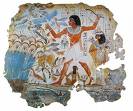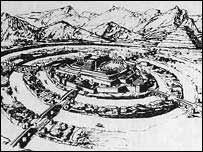
"American Origins: (As sent to me by Brian Dodd)Quote from ENCARTA 95
The American version of the Santa Claus figure received its inspiration and its name from the Dutch legend of Sinter Klaas, brought by settlers to New York in the 17th century.
As early as 1773 the name appeared in the American press as "St. A Claus," but it was the popular author Washington Irving who gave Americans their first detailed information about the Dutch version of Saint Nicholas. In his History of New York, published in 1809 under the pseudonym Diedrich Knickerbocker, Irving described the arrival of the saint on horseback (unaccompanied by Black Peter) each Eve of Saint Nicholas.
This Dutch-American Saint Nick achieved his fully Americanized form in 1823 in the poem A Visit From Saint Nicholas more commonly known as The Night Before Christmas by writer Clement Clarke Moore. Moore included such details as the names of the reindeer; Santa Claus's laughs, winks, and nods; and the method by which Saint Nicholas, referred to as an elf, returns up the chimney. (Moore's phrase "lays his finger aside of his nose" was drawn directly from Irving's 1809 description.)
The American image of Santa Claus was further elaborated by illustrator Thomas Nast, who depicted a rotund Santa for Christmas issues of Harper's magazine from the 1860s to the 1880s. Nast added such details as Santa's workshop at the North Pole and Santa's list of the good and bad children of the world. A human-sized version of Santa Claus, rather than the elf of Moore's poem, was depicted in a series of illustrations for Coca-Cola advertisements introduced in 1931. In modern versions of the Santa Claus legend, only his toy-shop workers are elves. Rudolph, the ninth reindeer, with a red and shiny nose, was invented in 1939 by an advertising writer for the Montgomery Ward Company.
In looking for the historical roots of Santa Claus, one must go very deep in the past. One discovers that Santa Claus as we know him is a combination of many different legends and mythical creatures.
The basis for the Christian-era Santa Claus is Bishop Nicholas of Smyrna (Izmir), in what is now Turkey. Nicholas lived in the 4th century A.D. He was very rich, generous, and loving toward children. Often he gave joy to poor children by throwing gifts in through their windows.
The Orthodox Church later raised St. Nicholas, miracle worker, to a position of great esteem. It was in his honor that Russia's oldest church, for example, was built. For its part, the Roman Catholic Church honored Nicholas as one who helped children and the poor. St. Nicholas became the patron saint of children and seafarers. His name day is December 6th.
In the Protestant areas of central and northern Germany, St. Nicholas later became known as der Weinachtsmann. In England he came to be called Father Christmas. St. Nicholas made his way to the United States with Dutch immigrants, and began to be referred to as Santa Claus.
In North American poetry and illustrations, Santa Claus, in his white beard, red jacket and pompom-topped cap, would sally forth on the night before Christmas in his sleigh, pulled by eight reindeer, and climb down chimneys to leave his gifts in stockings children set out on the fireplace's mantelpiece.
Children naturally wanted to know where Santa Claus actually came from. Where did he live when he wasn't delivering presents? Those questions gave rise to the legend that Santa Claus lived at the North Pole, where his Christmas-gift workshop was also located.
In 1925, since grazing reindeer would not be possible at the North Pole, newspapers revealed that Santa Claus in fact lived in Finnish Lapland. "Uncle Markus", Markus Rautio, who compared the popular "Children's hour" on Finnish public radio, revealed the great secret for the first time in 1927: Santa Claus lives on Lapland's Korvatunturi - "Ear Fell"
The fell, which is situated directly on Finland's eastern frontier, somewhat resembles a hare's ears - which are in fact Santa Claus's ears, with which he listens to hear if the world's children are being nice. Santa has the assistance of a busy group of elves, who have quite their own history in Scandinanvian legend.
Over the centuries, customs from different parts of the Northern Hemisphere thus came together and created the whole world's Santa Claus - the ageless, timeless, deathless white-bearded man who gives out gifts on Christmas and always returns to Korvatunturi in Finnish Lapland.
Since the 1950s, Santa has happily sojourned at Napapiiri, near Rovaniemi, at times other than Christmas, to meet children and the young at heart. By 1985 his visits to Napapiiri had become so regular that he established his own Santa Claus Office there. He comes there every day of the year to hear what children want for Christmas and to talk with children who have arrived from around the world. Santa Claus Village is also the location of Santa's main Post Office, which receives children's letters from the four corners of the world.
Learn more about the First Christmas Tree. The location of this first recorded evergreen tree being used in a new year (Christmas) celebration was in Town Hall Square in Riga Latvia 1510. Vist http://history.firstchristmastree.com/
Learn more about the First Christmas Tree. The location of this first recorded evergreen tree being used in a new year (Christmas) celebration was in Town Hall Square in Riga Latvia 1510. Vist http://history.firstchristmastree.com/
....................
copyright : http://www.the-north-pole.com/history/




